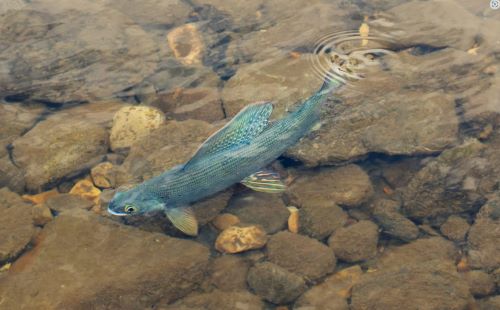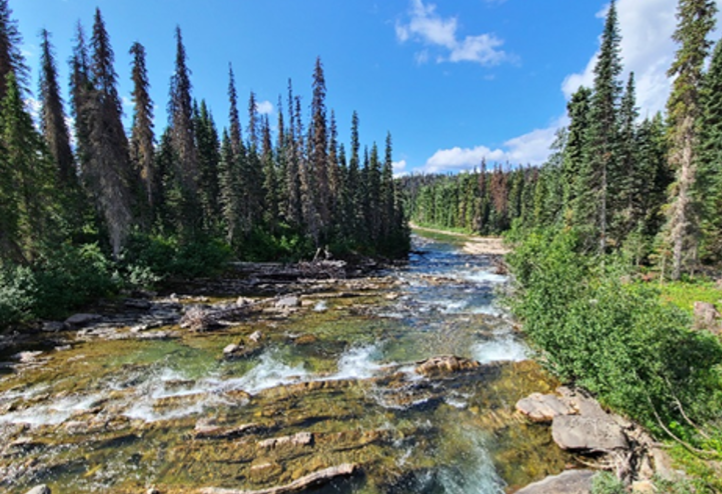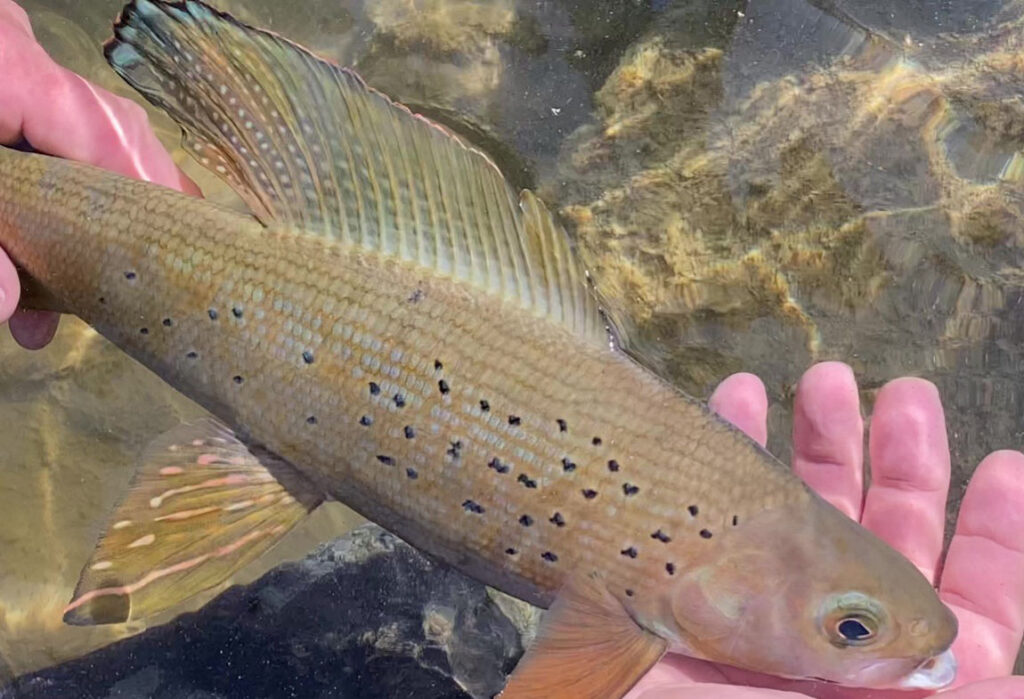B.C.’s northern rivers are home to Arctic grayling
Blog originally published June 2020.
Arctic grayling (Thymallus arcticus) are arguably the most visually attractive of the fish species native to British Columbia. With their unique sail-like dorsal fin (especially prominent in mature males), the adult stage of these sleek, silvery fish is not likely to be confused with any other species. Arctic grayling make their home in B.C.’s northern rivers, primarily the Peace and Liard drainages, as well as some upper sections of the coastal Stikine, Taku, and Alsek rivers.
Since they are generally smaller, Arctic grayling might not enjoy the same prestige as other B.C. sport fish. And limited to the north, access to them may be a challenge. For those who do seek them out, however, the experience can be incredibly rewarding. Remote wilderness settings tucked into mountain ranges, gin-clear waters where you may never come across another human being, and wild-only fish populations create a sense of connection with nature that should appeal to the most discerning of anglers.
The Arctic grayling’s voracity for anything resembling prey is an especially attractive trait that can produce a fantastic day of dry-fly fishing. Yet even in seemingly remote locations where fishing pressure is more limited, it’s this same trait that makes Arctic grayling highly vulnerable to overfishing.
Status of Arctic grayling populations
Arctic grayling populations in the Parsnip drainage are of interest to provincial fisheries biologists, local First Nations, and the local angling community. Located in the Upper Peace watershed, the Parsnip was one of many rivers to be significantly impacted by flooding when the W.A.C. Bennett Dam was constructed on the Peace River in the mid 1960s. The dam created the immense Williston Reservoir, and connectivity among many tributaries of the Upper Peace system was lost.
Riverine species like the Parsnip’s Arctic grayling undergo complex feeding, spawning, and overwintering migrations. They rely upon a diet that consists mainly of drifting benthic (bottom-dwelling) insects. With the creation of the reservoir, productivity declined significantly, and temperature regimes changed; predator-and-competitor species that do well in lake-like conditions began to dominate. In addition, migratory Arctic grayling populations in the Peace watershed rely on large mainstem rivers to rear as juveniles. When these riverine habitats were flooded, they were no longer available to juveniles.


Vulnerability due to increased angling is another factor, as more roads provide greater access (along with habitat degradation associated with road construction, forestry, and pipeline development). Once common throughout the upper Peace and its tributaries, Arctic grayling now appear to be limited to only eight of the Peace River’s largest tributary systems, including the Parsnip. And even on the Parsnip, the species has been eliminated from its lower sections. This represents a massive reduction in the Arctic grayling’s distribution as well as overall abundance.
The numbers of Arctic grayling in the Parsnip, and in other tributaries of the Peace impacted by the W.A.C. Bennett Dam, can never return to their pre-dam levels. However, protective measures can ensure that the remnant populations remain robust, and able to support fisheries. To provide adequate protection, biologists must be able to identify critical habitat, and track fish abundance.
Assessment to answer key questions
In 2018, provincial biologists, in partnership with John Hagen and Associates and the BC Hydro Fish and Wildlife Compensation Program for the Peace Region, initiated a multi-year project to assess the abundance of Arctic grayling in the Anzac and Table rivers, as well as the less-studied Missinka River. These rivers are key tributaries of the Parsnip, and assessments had not been conducted for over 10 years. Given their proximity to Prince George, these rivers see fair levels of angling activity. In addition, there is increased forestry due to recent spruce beetle outbreaks, and a gas pipeline development is underway in the Anzac watershed. Concerned that these changes may have reduced numbers of Arctic grayling, the biologists were especially interested in these key questions:
- How does current abundance of Arctic grayling compare to previous levels from 1995-2007?
- Are current fishing regulations adequate to protect Arctic grayling from overharvesting and fishing-related death? Anglers should note that in the Omineca region there is a spring closure of all streams to fishing from April 1 – June 30 each year (see tables for exceptions), and Arctic grayling are catch-and-release only.
- Where are critical summer rearing habitats for Arctic grayling, and should these receive stronger protection?
Since the Anzac and Table rivers have highly transparent waters, especially during lower flows in summer and fall, snorkel surveys to count fish are possible. While seemingly simple in concept, these snorkel surveys are logistically challenging given the remote locations involved – along with daunting rapids in some sections. To safely deliver accurate counts, the surveys require significant manpower in the form of three teams of two biologists plus a safety boater, all working in concert.
In August 2018 and 2019 (when the visibility was good, and fish were in their summer feeding habitats), sections of the river that had been previously assessed every year from 1995 to 2007 were swum again by these survey teams to count numbers of Arctic grayling. Fish distribution patterns were described, and numbers of fish at specific sites were compared to previous counts. As efforts to refine methodologies continue, the results to date should be considered provisional, but some preliminary observations have been made:
- Numbers of Arctic grayling appear to have increased. This suggests that the catch-and-release angling regulations now in place are effective in maintaining a sustainable sport fishery.
- Relatively high numbers of Arctic grayling during summer months confirm that the Table and Anzac rivers contain important summer habitats, compared to the Missinka River, where spatial extent of use and fish numbers appear lower.
This partnership project is ongoing, with the intent to better identify key locations of critical habitats, and to refine abundance estimates. A collaboration with researchers at the University of Northern British Columbia is assisting to ensure that snorkel counts reflect accurate estimates of abundance.
To improve our understanding of this sensitive sport fish species, the Freshwater Fisheries Society of BC is pleased to have contributed funds to the first two years of this work. The Society is continuing its support as the project goes into its third year.
This blog series has been established as a way to inform freshwater anglers in B.C. about projects, such as this one, that their angling licence dollars support. In 2015, the Freshwater Fisheries Society of BC began receiving 100% (up from 70%) of all freshwater angling licence fees. With this additional funding, the Society committed to broadening the scope of its activities to include joint initiatives with the Provincial Government to support projects that benefit freshwater recreational fishing around B.C.
Author: Sue Pollard, Freshwater Fisheries Society of BC
